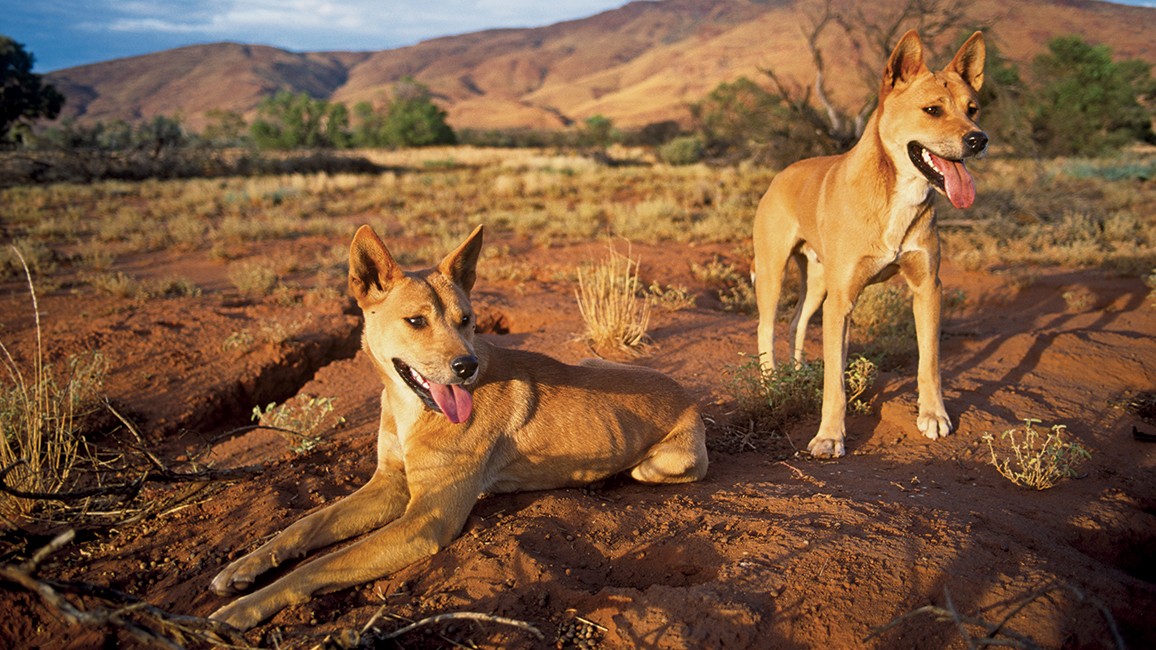
Year of the Dog
By Hannah SchardtYou may have heard that every dog has its day. In the Chinese calendar, dogs get a whole year! And that year is just about to start. February 16 is the first day of the Chinese, or lunar, new year—and the first day of the Year of the Dog!
The perky goldendoodle in the photo above left looks ready to get the party started. But who invited the splotchy, round-eared animal in the photo above right? We did! That’s an African wild dog, and it’s just as much a part of the dog family as the goldendoodle is.
Some wild members of the dog family look a lot like dogs we keep as pets. Others look doggone different!
DHOLE
Crunch, crunch! That’s no chew toy in the mouth of this dhole (DOHL). The German shepherd-sized dog is snacking on leftovers from a dinner of deer. Dholes, which live in Asia, hunt in packs to bring down large prey. To communicate with other members of the pack, they don’t bark—they whistle! Their piercing calls help them keep in touch in the dense forests where they live.
AFRICAN WILD DOG
These super-social dogs live and hunt in packs, sharing food and helping care for members that are weak or injured. Above, two watchful adults herd the pack’s pups to a new den. They trot along slowly when there are pups to mind. But when the hunt is on, African wild dogs can sprint faster than 40 miles an hour! They are the fastest of all wild dogs.
GRAY WOLF
This mighty predator is the largest wild dog. It can weigh as much as a grown man. And an adult gray wolf can eat nearly 20 pounds of meat in a single meal. The wolf lives in parts of North America and Eurasia and is the closest wild relative of every domestic dog—even a Chihuahua!
BLACK-BACKED JACKAL
The jackal is a fierce hunter—just ask these startled doves! But this African dog is also a gentle, attentive parent. In a close-knit jackal family, Mom and Dad stick together for life. Both take care of their pups—feeding, grooming, and protecting them from danger. Full-grown jackal brothers and sisters often stick around for a year to help care for a new batch of pups.
DINGO
Scientists believe this wild dog—Australia’s largest meat-eating mammal—may have once been kept as a pet. If so, somewhere along the line, the dingo turned wild again. When Europeans came to Australia, they turned a lot of dingo habitat into farms and ranches. Eventually, Australians built the world’s longest fence—3,500 miles long!—to keep their livestock away from hungry dingoes.
GRAY FOX
Wait—aren’t cats supposed to climb trees? Dogs usually keep their feet on the ground. But the gray fox will scramble up a tree to escape danger, to look for food, or even to snooze. This fox, found in parts of North and South America, has strong, hooked claws to help it climb. When it’s time to go down, it may leap from branch to branch or scooch backward down the trunk like a cat.
RACCOON DOG
Wait . . . how did Ranger Rick sneak in here? Actually, this Asian black-masked bird-snatcher (see those feathers?) is no raccoon. It’s all dog. In fact, scientists believe the raccoon dog is a lot like the basic, ancient dogs that lived millions of years ago
FENNEC FOX
The smallest member of the dog family lives in Africa’s hot, sandy Sahara Desert. The fennec fox’s huge ears are full of blood vessels, which help draw heat away from the body. The supersized ears are also super sensitive: They can hear the sounds of beetles or other prey moving underground.
MANED WOLF
This graceful-looking dog is found in parts of South America, where those stilt-like legs help it see above tall grass. The maned wolf’s deep call sounds more like a lion’s roar than a wolf’s howl. But despite that roar and its fuzzy mane, it isn’t a lion. And it isn’t a true wolf, either. It’s a one-of-a-kind dog.
BUSH DOG
With its squat body and rounded head, it looks like a miniature bear. But the bush dog of Central and South America is a dog, indeed! As many dogs do, bush dogs live in packs. Working together, a pack can bring down prey as large as the giant, pig-like tapir. Hot dog!



















